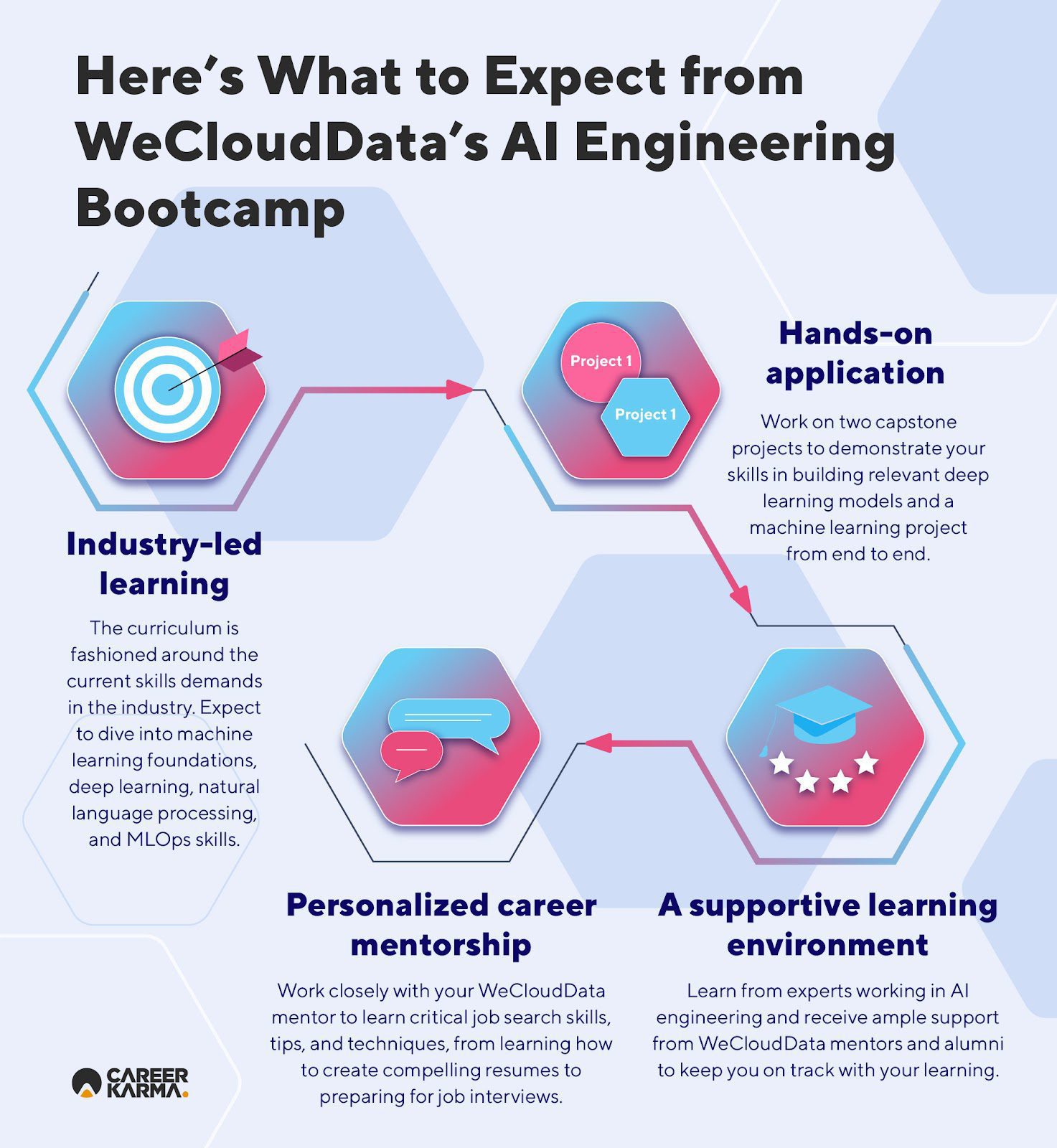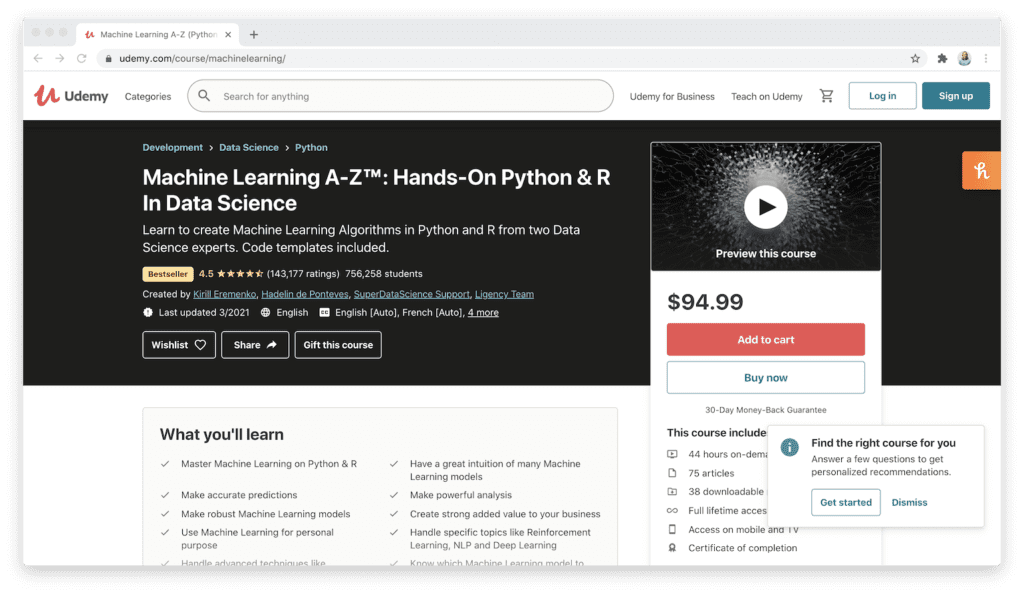All Categories
Featured
Table of Contents
- – Some Known Details About Fundamentals Of Machi...
- – The Facts About Software Engineering For Ai-en...
- – The Facts About No Code Ai And Machine Learni...
- – What Does Zuzoovn/machine-learning-for-softwa...
- – How To Become A Machine Learning Engineer In...
- – How Certificate In Machine Learning can Save...
- – Things about How To Become A Machine Learnin...
Some people think that that's dishonesty. If someone else did it, I'm going to utilize what that person did. I'm requiring myself to assume with the feasible remedies.
Dig a little bit deeper in the math at the beginning, just so I can construct that structure. Santiago: Finally, lesson number 7. I do not believe that you have to understand the nuts and screws of every formula prior to you utilize it.
I would have to go and inspect back to actually obtain a much better instinct. That doesn't indicate that I can not fix points utilizing neural networks? It goes back to our sorting instance I believe that's just bullshit advice.
As an engineer, I have actually worked on lots of, many systems and I have actually utilized many, several things that I do not understand the nuts and bolts of exactly how it functions, even though I comprehend the impact that they have. That's the final lesson on that particular thread. Alexey: The funny point is when I assume about all these libraries like Scikit-Learn the formulas they use inside to execute, as an example, logistic regression or something else, are not the exact same as the algorithms we research in artificial intelligence courses.
Some Known Details About Fundamentals Of Machine Learning For Software Engineers
Even if we attempted to find out to get all these fundamentals of equipment discovering, at the end, the algorithms that these collections use are various. Santiago: Yeah, definitely. I assume we require a whole lot much more materialism in the sector.

Incidentally, there are two various courses. I usually speak with those that desire to operate in the industry that intend to have their impact there. There is a course for researchers which is totally various. I do not dare to talk regarding that since I don't understand.
Right there outside, in the market, materialism goes a lengthy method for certain. (32:13) Alexey: We had a remark that stated "Feels even more like inspirational speech than chatting regarding transitioning." So possibly we must change. (32:40) Santiago: There you go, yeah. (32:48) Alexey: It is an excellent inspirational speech.
The Facts About Software Engineering For Ai-enabled Systems (Se4ai) Uncovered
One of things I desired to ask you. I am taking a note to speak about ending up being much better at coding. First, let's cover a couple of things. (32:50) Alexey: Allow's begin with core devices and structures that you need to discover to actually shift. Let's claim I am a software application engineer.
I know Java. I recognize how to use Git. Maybe I recognize Docker.
What are the core devices and frameworks that I require to find out to do this? (33:10) Santiago: Yeah, absolutely. Great inquiry. I assume, number one, you should begin learning a bit of Python. Since you already know Java, I do not think it's mosting likely to be a substantial change for you.
Not since Python is the very same as Java, yet in a week, you're gon na obtain a whole lot of the distinctions there. Santiago: Then you get particular core devices that are going to be made use of throughout your whole profession.
The Facts About No Code Ai And Machine Learning: Building Data Science ... Revealed
That's a collection on Pandas for data adjustment. And Matplotlib and Seaborn and Plotly. Those three, or among those 3, for charting and presenting graphics. After that you obtain SciKit Learn for the collection of device knowing formulas. Those are devices that you're mosting likely to have to be using. I do not suggest simply going and finding out about them unexpectedly.
Take one of those training courses that are going to start presenting you to some issues and to some core ideas of device discovering. I don't keep in mind the name, yet if you go to Kaggle, they have tutorials there for free.
What's great concerning it is that the only requirement for you is to recognize Python. They're mosting likely to provide a problem and tell you exactly how to make use of choice trees to fix that particular issue. I assume that procedure is incredibly effective, because you go from no machine learning history, to comprehending what the problem is and why you can not fix it with what you recognize right currently, which is straight software program engineering practices.
What Does Zuzoovn/machine-learning-for-software-engineers Do?
On the other hand, ML engineers concentrate on building and deploying machine knowing designs. They focus on training models with data to make predictions or automate jobs. While there is overlap, AI designers handle even more diverse AI applications, while ML designers have a narrower concentrate on equipment knowing formulas and their useful implementation.

Artificial intelligence engineers concentrate on developing and releasing artificial intelligence designs into manufacturing systems. They service engineering, making sure versions are scalable, reliable, and integrated right into applications. On the other hand, data researchers have a more comprehensive role that consists of information collection, cleaning, exploration, and structure models. They are frequently in charge of drawing out insights and making data-driven choices.
As companies increasingly adopt AI and device discovering modern technologies, the need for skilled experts grows. Artificial intelligence engineers service innovative jobs, add to development, and have affordable salaries. Nevertheless, success in this field calls for continual knowing and keeping up with progressing innovations and techniques. Artificial intelligence functions are usually well-paid, with the possibility for high making capacity.
ML is fundamentally different from standard software program growth as it concentrates on training computer systems to gain from information, rather than programs specific rules that are executed systematically. Uncertainty of end results: You are probably utilized to writing code with foreseeable outcomes, whether your feature runs as soon as or a thousand times. In ML, nevertheless, the outcomes are less certain.

Pre-training and fine-tuning: Just how these models are educated on large datasets and after that fine-tuned for specific tasks. Applications of LLMs: Such as text generation, belief analysis and details search and retrieval. Papers like "Attention is All You Need" by Vaswani et al., which introduced transformers. On the internet tutorials and programs concentrating on NLP and transformers, such as the Hugging Face course on transformers.
How To Become A Machine Learning Engineer In 2025 Can Be Fun For Anyone
The capacity to handle codebases, combine changes, and settle conflicts is just as important in ML development as it is in standard software projects. The skills created in debugging and testing software program applications are very transferable. While the context may transform from debugging application reasoning to identifying problems in data processing or version training the underlying principles of organized examination, theory screening, and repetitive improvement are the exact same.
Artificial intelligence, at its core, is greatly dependent on data and likelihood theory. These are critical for understanding just how formulas pick up from data, make predictions, and examine their performance. You must think about coming to be comfortable with concepts like analytical significance, circulations, theory testing, and Bayesian reasoning in order to layout and translate versions properly.
For those interested in LLMs, a detailed understanding of deep discovering architectures is valuable. This includes not just the mechanics of neural networks but likewise the style of certain versions for different usage cases, like CNNs (Convolutional Neural Networks) for image handling and RNNs (Frequent Neural Networks) and transformers for consecutive data and all-natural language processing.
You must know these concerns and find out techniques for recognizing, minimizing, and interacting regarding prejudice in ML models. This consists of the prospective impact of automated choices and the moral implications. Several versions, especially LLMs, need significant computational sources that are usually offered by cloud systems like AWS, Google Cloud, and Azure.
Building these abilities will certainly not just help with an effective shift into ML yet likewise make certain that designers can add properly and properly to the innovation of this vibrant area. Concept is essential, yet absolutely nothing defeats hands-on experience. Begin working with projects that enable you to use what you have actually discovered in a sensible context.
Participate in competitions: Join systems like Kaggle to get involved in NLP competitors. Construct your projects: Start with simple applications, such as a chatbot or a message summarization device, and slowly raise complexity. The field of ML and LLMs is swiftly developing, with new advancements and technologies emerging routinely. Staying updated with the most recent study and trends is essential.
How Certificate In Machine Learning can Save You Time, Stress, and Money.
Contribute to open-source projects or compose blog messages about your understanding journey and projects. As you get expertise, start looking for opportunities to integrate ML and LLMs into your work, or seek new functions focused on these innovations.

Prospective usage instances in interactive software application, such as suggestion systems and automated decision-making. Understanding unpredictability, standard statistical steps, and chance distributions. Vectors, matrices, and their duty in ML formulas. Error reduction techniques and gradient descent described merely. Terms like model, dataset, attributes, labels, training, inference, and recognition. Information collection, preprocessing strategies, version training, evaluation procedures, and release considerations.
Decision Trees and Random Forests: Instinctive and interpretable designs. Assistance Vector Machines: Optimum margin classification. Matching issue types with ideal versions. Balancing efficiency and complexity. Standard framework of neural networks: nerve cells, layers, activation functions. Split calculation and onward propagation. Feedforward Networks, Convolutional Neural Networks (CNNs), Frequent Neural Networks (RNNs). Photo recognition, series forecast, and time-series analysis.
Continual Integration/Continuous Implementation (CI/CD) for ML process. Design surveillance, versioning, and efficiency tracking. Finding and dealing with adjustments in version performance over time.
Things about How To Become A Machine Learning Engineer In 2025
Program OverviewMachine discovering is the future for the future generation of software program experts. This training course functions as an overview to artificial intelligence for software application designers. You'll be presented to 3 of the most appropriate elements of the AI/ML discipline; monitored discovering, semantic networks, and deep learning. You'll comprehend the differences between typical programs and machine knowing by hands-on advancement in monitored learning before building out intricate dispersed applications with semantic networks.
This training course acts as an overview to equipment lear ... Program Much more.
Table of Contents
- – Some Known Details About Fundamentals Of Machi...
- – The Facts About Software Engineering For Ai-en...
- – The Facts About No Code Ai And Machine Learni...
- – What Does Zuzoovn/machine-learning-for-softwa...
- – How To Become A Machine Learning Engineer In...
- – How Certificate In Machine Learning can Save...
- – Things about How To Become A Machine Learnin...
Latest Posts
How To Use Youtube For Free Software Engineering Interview Prep
Interview Prep Guide For Software Engineers – Code Talent's Complete Guide
How To Ace The Software Engineering Interview – Insider Strategies
More
Latest Posts
How To Use Youtube For Free Software Engineering Interview Prep
Interview Prep Guide For Software Engineers – Code Talent's Complete Guide
How To Ace The Software Engineering Interview – Insider Strategies